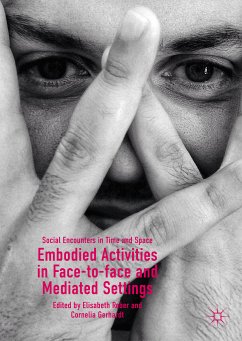This edited book revisits the concept of social 'activities' from an interactional perspective, examining how verbal, vocal, visual-spatial and material resources are deployed by participants for meaning-making in social encounters. The eleven original chapters within this volume analyse activities based on video recordings of naturalistic and naturally occurring social encounters from face-to-face and mediated settings in Chinese, Dutch, English, French, and German. Informed primarily by the methodological approaches of Conversation Analysis and Interactional Linguistics, the authors study embodiment in space and time in three distinct types of situations: objects in space, complex participation frameworks, and affiliation and alignment. Moreover, the book includes a theoretical and methodological discussion of how activities are constituted and visibly embodied in interaction. It will be of interest to students and scholars in sociology and linguistics in general, and face-to-face and mediated interaction in particular.
Elisabeth Reber is a postdoctoral researcher and lecturer in English Linguistics at the University of Würzburg, Germany. She is co-convener of the DFG-funded scientific network "Multimodality and Embodied Interaction" (with Cornelia Gerhardt) and author of the monograph Affectivity in Interaction: Sound Objects in English (2012).
Cornelia Gerhardt is lecturer in English Linguistics at Saarland University, Germany. Her research interests include the interactional appropriation of media and the embodiment of language at the interface with social phenomena such as football and food. Her previous books include Appropriating Live Televised Football through Talk (2014) and Culinary Linguistics (2013).
Dieser Download kann aus rechtlichen Gründen nur mit Rechnungsadresse in A, B, BG, CY, CZ, D, DK, EW, E, FIN, F, GR, HR, H, IRL, I, LT, L, LR, M, NL, PL, P, R, S, SLO, SK ausgeliefert werden.
"The contributions in the book are easy to read, which makes the book accessible for doctoral researchers or students of linguistics or sociology who are interested in interactional research. ... the volume is suitable for senior scholars generally interested in human interaction; it serves as a great handbook of social activities in the fields of Conversation Analysis and Interactional Linguistics. Finally, the contributions in the volume are of high quality and worth reading in their own right." (Journal of Pragmatics, Vol. 156, 2020)
Es gelten unsere Allgemeinen Geschäftsbedingungen: www.buecher.de/agb
Impressum
www.buecher.de ist ein Internetauftritt der buecher.de internetstores GmbH
Geschäftsführung: Monica Sawhney | Roland Kölbl | Günter Hilger
Sitz der Gesellschaft: Batheyer Straße 115 - 117, 58099 Hagen
Postanschrift: Bürgermeister-Wegele-Str. 12, 86167 Augsburg
Amtsgericht Hagen HRB 13257
Steuernummer: 321/5800/1497
USt-IdNr: DE450055826
Bitte wählen Sie Ihr Anliegen aus.
Rechnungen
Retourenschein anfordern
Bestellstatus
Storno









